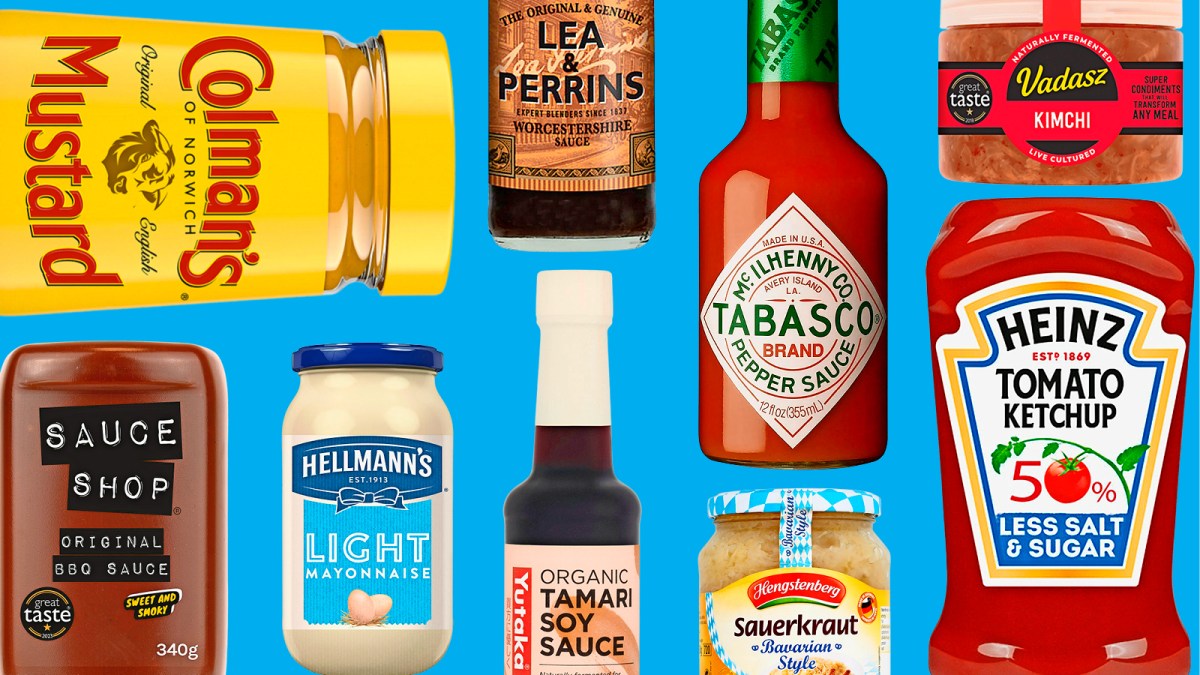Condiments can make or break a meal. Who doesn’t love a chip dipped in garlicky mayo, a squirt of ketchup in their burger or a dollop of tangy mustard in their potato salad? But with big flavours often comes a nutrition label high in fat, salt, sugar and additives.
Nichola Ludlam-Raine, the dietician and author of How Not to Eat Ultra-Processed, says the key things to look out for are the sugar and salt content. “Ketchup, brown sauce and barbecue sauces are surprisingly high in both,” she says. Ideally, when reading a food label, you want the sugar to be less than 5g and salt less than 0.3g per 100g. But given the nature of condiments, many exceed this. “Also, the label doesn’t differentiate between added sugar and sugar naturally occurring from the tomatoes,” Ludlam-Raine says. “So look for ‘reduced sugar’ or ‘no added sugar’, and check the ingredients list too; the higher up tomatoes are listed (as opposed to sugar or glucose-fructose syrup), the better.”
If you tend to eat healthily, there is no need to feel guilty about the mayo in your sandwich. But if you’re in the habit of smothering ketchup indiscriminately on most things, it might be worth considering other ways to get a hit of flavour and moisture. “I like to use hummus in my sandwiches, as it provides fibre and plant protein,” Ludlam-Raine says. “And pesto or tapenade are flavourful and nutritious, especially when made with olives, olive oil or nuts.”
This is how your favourite condiments measure up.
Tomato ketchup
The nation’s favourite condiment is synonymous with Heinz, whose original recipe contains 22.8g sugar and 1.8g salt per 100g. Heinz now does a No Added Salt & Sugar version, with 4.4g sugar (naturally occurring in the tomatoes) and 0.05g salt per 100g, though it does contain sucralose, an artificial sweetener. As a halfway house, it also now offers a 50% Less version, the taste of which is indistinguishable from the original for all but the most seasoned ketchup connoisseur.
• What is the best tomato ketchup? The supermarket brands, ranked

Tomato ketchup is the most popular condiment in Britain
GETTY IMAGES
Mayonnaise
Made with rapeseed oil and eggs, mayonnaise is relatively high in fat, so again it depends on your priorities. If you want to reduce calories, go for the light version (Hellmann’s Light Mayonnaise has 2.6g saturated fat per 100g, compared with 6.1g in the original). But it does contain thickeners such as xanthan gum to compensate for the watered-down oil content, so anyone avoiding additives might prefer to stick with the original and just have less.
Many consider aïoli a healthier option but is it? “While delicious, aïoli is essentially garlic mayo,” Ludlam-Raine says. “It’s often made with olive oil, which is a healthier fat but is still high in calories and should be used in moderation.”
• What is the best mayonnaise to buy now? Seven brands, ranked
Worcestershire sauce
A few drops of Worcestershire sauce on a slice of cheese on toast elevates it from “can’t be bothered to cook” to “ta-da!” In terms of calories, fat and sugar, it’s pretty healthy. But it is generally high in salt, so if you are concerned about your heart, either look for lower-salt versions or simply use sparingly.
Barbecue sauce
That sweet smokey tang particular to BBQ sauce is the perfect way to offset a burger. But barbecue sauce is up there with the most sugar-packed condiments. Sainsbury’s own-brand version contains a mind-boggling 32.1g sugar per 100g, and there are few reduced sugar alternatives in this market. Consider what it is about barbecue sauce that you love. If it’s spiciness or smokiness, then there is likely to be a type of hot sauce with far less sugar that will hit the spot.
• How much sugar are you really eating?
Mustard
Typically made with water and mustard flour, mustard is low in calories, sugar and fat. English mustard has a stronger flavour, so you can use less of it, whereas French mustard such as Dijon is milder. “Nutritionally they are quite similar, so it comes down to preference,” Ludlam-Raine says. “Just check the label if you’re watching your salt intake, as some varieties can be a little salty.”
Hot sauce
Hot sauces use strong natural flavours from bird’s eye chilli, jalapeño and cayenne pepper to negate the need for lots of sugar or additives. “Sauces such as sriracha or Tabasco are usually low in calories and sugar, and some even contain antioxidants such as capsaicin, which may have anti-inflammatory effects,” Ludlam-Raine says. “Again, keep an eye on salt content, which can vary significantly. And a little goes a long way, especially if you have a sensitive gut.”
• What is the best English mustard? Seven brands, tried and tested
Soy sauce
The salty staple is a double-edged sword. On one hand, Ludlam-Raine says, it contains some antioxidants and amino acids, especially if traditionally brewed. “However, it’s very high in sodium — one teaspoon can contain nearly half your daily recommended salt intake. Look for reduced-sodium versions and use sparingly.” Try tamari, a Japanese soy sauce that is usually higher in protein and lower in salt.
Pickles
Nothing pimps up a boring old cheese sandwich like a blob of pickle. But when it comes to nutritional benefits there are pickles and there are pickles. “Fermented pickles, such as kimchi, sauerkraut or traditional dill pickles contain beneficial bacteria that support gut health,” Ludlam-Raine says. “Products such as Branston pickle are more of a sweet chutney — higher in sugar and salt, with fewer health benefits. It’s still fine to enjoy occasionally but it’s not in the same category as fermented foods.” If you can bear to switch out your Branston for some kimchi, it will help your gut microbiome thrive.
